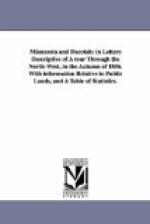The great panorama which time paints is but a species of dissolving views. It is but as yesterday since the present sites of towns and cities on the shores just referred to showed only the rude huts of Indian tribes. To-day, the only vestige left there of the Indian are his burying-grounds. Hereafter the rudeness of pioneer life shall be exchanged for a more genial civilization, and the present, then the past, will be looked back to as trivial by men still yearning for the future.
LETTER III.
City of st. Paul.
First settlement of St. Paul— Population— Appearance of the city— Fuller House— Visitors— Roads— Minneapolis— St. Anthony— Suspension Bridge.
Fuller house, st. Paul, October, 1856.
The circumstance of finding a good spring of water first led to the settlement of Boston. It would not be unreasonable to suppose that a similar advantage induced the first settler of St. Paul to locate here; for I do not suppose its pioneers for a long while dreamed of its becoming a place even of its present importance. And here let me mention that St. Paul is not on the west side of the Mississippi, but on the east. Though it is rather too elevated and rough in its natural state to have been coveted for a farm, it is yet just such a spot as a pioneer would like to plant himself upon, that he might stand in his door and have a broad and beautiful view towards the south and west. And when the speculator came he saw that it was at the head of navigation of what be thought was the Upper Mississippi, but which in reality is only the Middle Mississippi. Then stores were put up, small and rude, and trade began to increase with settlers and hunters of furs. Then came the organization of the territory, and the location of the capital here, so that St. Paul began to thrive still more from the crumbs which fell from the government table, as also by that flood of emigration which nothing except the Rocky Mountains has ever stayed from entering a new territory. And now it has passed its doubtful era. It has passed from its wooden to its brick age. Before men are certain of the success of a town, they erect one story pine shops; but when its success appears certain, they build high blocks of brick or granite stores. So now it is common to see four and five story brick or stone buildings going up in St. Paul.
I believe this city numbers at present about 10,000 population. It is destined to increase for a few years still more rapidly than it has heretofore. But that it will be a second Chicago is what I do not expect. It would certainly seem that the high prices demanded for building lots must retard the progress of the place; but I am told the prices have always been as high in proportion to the business and number of population. $500 and upwards is asked for a decent building lot in remote parts of the town.




